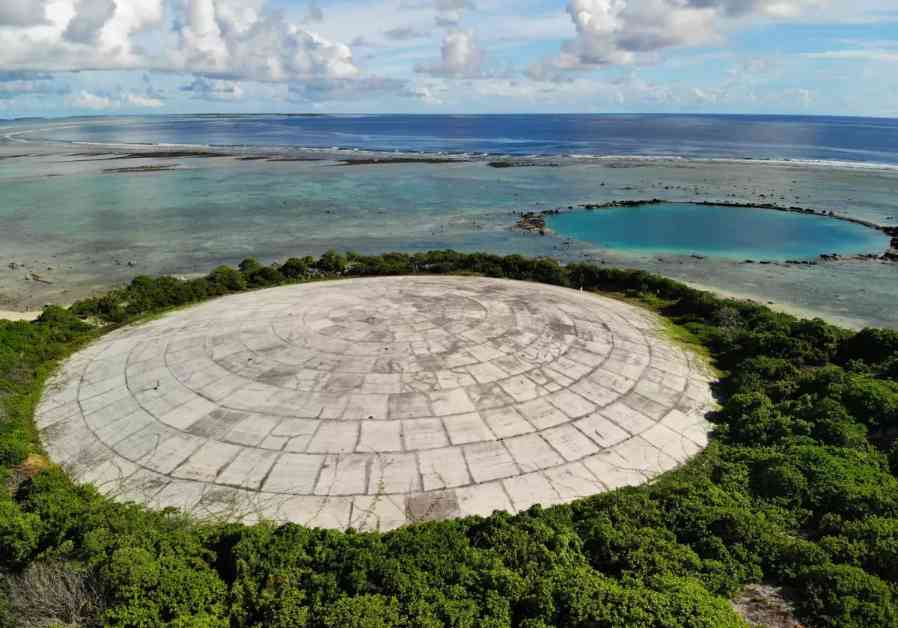In the heart of the Pacific Ocean lies the Marshall Islands, a picturesque paradise marred by a concrete dome filled with deadly nuclear waste. Known as the Runit Dome, this massive structure was built to contain the radioactive remnants of America’s Cold War nuclear tests. However, after decades of neglect, the radioactive shield now shows cracking, threatening the safety of the island’s inhabitants and the environment.
The U.S. government seized the Marshall Islands, a chain of atolls in the middle of the Pacific Ocean, from imperial Japan in 1944. The islands were eventually granted independence in 1979, but still retain a “free association” with the U.S. Along with Micronesia and Palau, the Marshall Islands are technically self-governing but are largely dependent on Washington for funding. To this day, the Marshall Islands use the US dollar as its currency and are also host to American military bases.
At the height of its control over the Marshall Islands, the United States conducted 67 nuclear tests from 1946 to 1958, seeking an edge in the Cold War. The archipelago’s remote location and sparse population made it an ideal testing ground. Massive bombs, including the death-bringing Castle Bravo hydrogen bomb, 1,000 times more powerful than the A-bomb dropped on Hiroshima and Nagasaki, leveled the Bikini Atoll and left radioactive waste behind. Even biological weapons were tested there during the 1960s and 1970s.
In the early 1970s, the natives of surrounding atolls threatened legal action against the U.S., claiming their livelihoods had been severely impacted by the decades of nuclear tests that destroyed entire islands and, worst of all, left a trail of radioactive waste. This was the beginning of the Marshall Islands independence movement but also the inception story of the Runit Dome.
Runit Island in the Enewetak Atoll was one of the most radioactively contaminated sites in the archipelago. Eleven nuclear tests were conducted on Runit, which left behind 3.1 million cubic feet of radioactive material with a half-life of 24,000 years.
The Atomic Energy Commission, (today’s Department of Energy) and the Department of Defense eventually came up with a plan. They collected radioactive debris from across the Enewetak Atoll and dumped it all in a single spot, a battered crater on Runit. Over the radioactive dump, the U.S. built an 18-inch thick concrete dome that stretched 377 feet wide.
Some 4,000 U.S. servicemen were involved in the debris cleanup and construction work — and the conditions were harsh. It was too hot to wear hazmat suits, so thousands of bare-chested soldiers shoveled tons of radioactive dirt. This would not be without consequences. Later in life, many of the troops suffered from cancer and even birth defects in their children.
Even still, the plight of US soldiers paled in comparison to that of the islanders. In a 2018 article, anthropologist Holly Barker said that over 200 locals who returned to Bikini Atoll after the construction had to be relocated again after “they were found to have ingested more radioactive cesium from the environment than any known human population.”
The dome, also known as “The Tomb,” was meant as a temporary solution, but it has now become a long-term concern. In 2019, the LA Times ran an expose, where they reviewed thousands of documents and interviews with U.S. and Marshallese officials. The journalists found that the American government withheld key information time and time again. For instance, the United States never told the Marshallese that in 1958, it shipped 130 tons of soil from its atomic testing grounds in Nevada to the Marshall Islands.
However, the most concerning revelation was that cracks were visible across the cap of the neglected concrete dome, which is surrounded by brackish water, unrestricted vines and foliage. To make matters worse, the Marshall Islands are some of the most vulnerable to climate change. Since 1993, sea levels have risen about 0.3 inches a year in the Marshall Islands, far higher than the global average of 0.11 to 0.14 inches. Most of the Marshall Islands could be submerged by the end of the century.
Throughout the decades, storms and soil shifting have caused cracks in the dome to the point that local authorities now fear that the concrete could split during the next big storm amplified by climate change. What’s particularly worrisome is that seawater is gaining access to the crater from underneath, as its bottom has not been lined with concrete.
Following the LA Times report, the Department of Energy was directed by Congress to develop repair plans. In 2020, the Department of Energy concluded in a report that the Runit Dome was in no immediate danger of collapse or breach and “that the radioactive material within is not expected to have any measurable adverse effect on the surrounding environment for the next twenty years.”
The US says it has discharged its responsibilities to the Marshall Islands, and because the dome is on Marshallese land, the onus is not on Washington to fix it.
For the people of the Marshall Islands, the dome represents both a painful past and a precarious future. The U.S. government’s reassurances fall short for many islanders who fear a looming ecological disaster. As climate change progresses, the integrity of the Runit Dome remains a critical issue. The Marshallese continue to grapple with the enduring consequences of nuclear testing, seeking justice and safety for their homeland.
“These are matters of life and death for us,” Jack Ading, a Marshallese senator from Enewetak Atoll told the Los Angeles Times. “We can’t afford to rely exclusively on reassurances from one source. We need neutral experts from the international community to weigh in.”
He added: “We didn’t know the Runit Dome waste dump would crack and leak… We didn’t know about climate change. We weren’t nuclear scientists who could independently verify what the U.S. was telling us. We were just island people who desperately wanted to return home.”






